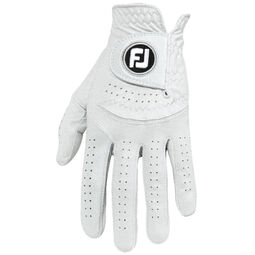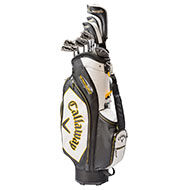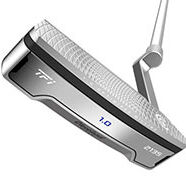2020 Golf Irons
Golf irons make up most of the golf clubs in a players’ bag. Choosing the ideal set can be one the most rewarding decisions a golfer makes in improving their game. With so many irons available, and with each offering different specifications, it can be tough trying to find out which are best for your game. This buying guide to 2020 golf irons offers useful advice on getting the golf iron that’s best for you.
Some of the best golf irons include the Cobra Golf King Forged Tec Steel Irons, which offer golfers the ideal balance of precision and distance. These clubs even come with electronically embedded sensors in the grips which automatically record the distance and accuracy of every shot so you can track your game and learn where to make improvements.
The TaylorMade P790 Steel Irons are another top-of-the-range iron with clean lines and hollow body construction to deliver unprecedented distances on the golf course. Through masterfully mixing forged construction and a revolutionary SPEEDFOAM™ technology, golfers can experience forgiveness and distance unlike any other of its calibre.
Another great option is the Callaway Golf Big Bertha Steel Irons. Big Bertha is an iconic name with a history of great performance, and Callaway Golf has produced a new iron which has ground braking Suspended Energy Core, for easy launch, distance, and incredible sound and feel. The Suspended Energy Core in this golf club is a construction that’s never been achieved before in a golf club. This groundbreaking construction suspends the MIM’d Tungsten weight using Callaway Golf`s proprietary Urethane microspheres.
Super Game-Improvement Irons - Most golfer who play exclusively at high handicap are often recommended to use super game-improvement irons as these offer greater forgiveness, a larger perimeter weighting and tend to have the highest available offset. This makes it much easier to hit for golfers who struggle to get the golf ball higher and straighter while at the driving range or out on the golf course.
Players within the handicap range of 21-28 (or total beginners) will find these clubs offer the lowest COG (Centre of Gravity) which helps to gain a higher and straighter golf ball flight. Beginners, or players within this handicap range, could also benefit from Package Sets.
Game-Improvement Irons - There’s more forgiveness to take advantage of if playing at mid-high handicap. Game-improvement irons, though easy to use, do tend to have a slight bias towards mid-handicap, but their low COG will get the golf ball higher at steeper launch angles.
Intermediate irons - Intermediate golf irons are all about dual performance and forgiveness. A mid to low handicap (8-17) is imperative for getting the most from these clubs, as putting one into the bag means a much less forgiving iron will be in play, meaning you must possess more skill when playing at this level. COG is slightly different from its game-improvement counterparts, too, utilising a steeper angle and less height carried onto the green.
Player’s Irons - Player’s irons are for the most experienced golfers only, for those who have mastered their own game and feel confident in their shot-shaping and feel. Golfers playing off a handicap of 0-10 (low) will benefit from these irons ten-fold. They can also enjoy the lowest, deepest COG available by using these irons.
Choosing the Right Iron Head
This section will show you which irons heads should be considered for golfers of all levels and stages in their development. Using the wrong set of irons can drastically hinder your improvement, but picking the correct type can help you improve leaps and bounds.
Over-sized Cavity Back
Oversized cavity back heads are the easiest golf clubs to hit. Their face surface area is generally bigger and easier to use due to the vast majority of its weight being stored around the perimeter of the iron head. The club face is usually much more forgiving than its smaller counterparts and off-centre hits will still allow you to hit the golf ball straighter, higher and further on the golf course.
Cavity Back
Still forgiving, cavity back irons are very similar to their over-sized version. They still remove weight from behind the centre of the club face and distribute more of the club head’s mass around the perimeter of the club head (but not as much as over-sized iron heads). With the change to the physical appearance and weighting characteristics, the physics of impact between club face and golf ball are also adjusted, resulting in a golf iron that’s very easy to hit, and achieves a wider range of forgiveness for golfers who have already taken their first steps.
Muscle Back
Muscle back irons have a full back of the club head as opposed to the hollowed out cavity back iron. Muscle back irons provide golfers with greater feedback, but also demand the golfer strike the golf ball much more consistently with the centre of the club face. By Using muscle back irons, players run the risk of losing a little distance and product worse performance on off-centre hits. Muscle backs have higher centre of gravity location than a cavity back iron, which produces lower trajectory that’s preferred by many golfers. These type of golf club are more "playable", meaning that the golfer can shape shots rather than relying on an iron that is designed to hit the ball straight.
Blade
Blade head irons have more weight positioned behind the middle of the golf club but are very unforgiving and any badly struck shot will be punished. Bladed irons tend to be forged and are generally preferred by only the top golfers because it allows them to more easily work the golf ball; plus, it feels softer at impact. Blades have a much smaller sweet spot, but the rewards for mastering this golf club head is well worth the practice.
Forged Head
Forged clubs are made by taking a piece of soft steel and beating it into shape. Many golfers claim that forged clubs offer better feel because the steel used in the forging process is softer due to the higher carbon content. Players who use forged clubs get softer feel with shots as well as greater control. The forged head is generally preferred by lower handicap golfers and costs a bit more, but better players will revel in its ability to help them save shots and feel great.
Cast Head
The vast majority of golfers, probably around 90% - purchase golf clubs made by casting – which involves pouring molten metal into a mould to produce a golf club head. This is a cheaper alternative to forged irons but many more golfers will find it easier to handle and be much more consistent than they might with the forged variety. Many companies will also tell about how soft cast heads are, but always remember that the harder the face of the club, the faster the golf ball will come off of it.
Steel Shafts
Steel shafts weigh more than their graphite counterparts and increase consistency at higher speeds swing speeds. Golfers whose swing speeds is between average to quick will benefit the most from using steel shafts. Some of the best steel shafts include True Temper, Project X, Nippon and KBS.
Graphite Shafts
Female and senior golfers (or just golfers with slow swing speeds in general) might fare slightly better with a graphite shaft, which weights less and produces quicker swing speeds for greater distance in each shot. They ideally they are suited to a player with slower swings. Some of the bigger names in graphite shafts are UST, Fujikura and Project X.
Shaft Flex
It’s important to consider shaft flex as it refers to the ability of a golf shaft to bend as more force is applied during golf swing. The force is determined by the kind of golf swing you possess; be it fast, slow, jerky or smooth, and there are 5 generally used ratings for shaft flex: Extra stiff, stiff, regular, Senior (or light) and ladies. As the shaft flexes throughout the swing, the position of the golf club head changes. The face of the golf club must be perfectly straight (squared) at impact to get the most out of every shot. There is less chance that you will make contact with the golf ball using a square club face if you have the wrong flex for your swing, so making sure this is correct should take prominence.
Custom Fitting
Get a Free Custom Fit with one of our Fitting Experts to help you make all these decisions. Fittings will be clear, concise and will cover all your needs. We are all different, that's why we make it personal.













